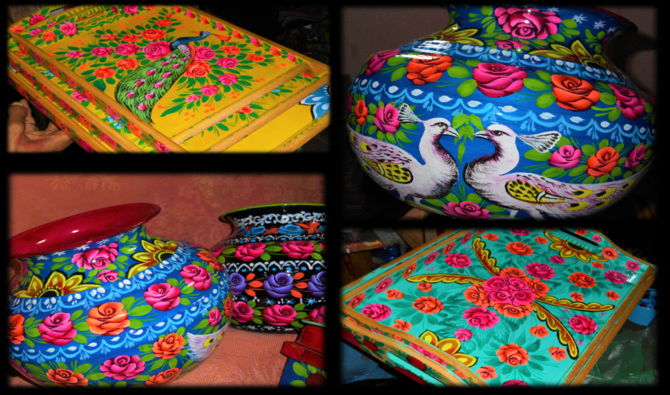KARACHI: In a small room of a building located in Saddar neighborhood in the heart of Karachi, Shahzad Hussain, 46, is making final touches to a brightly colored teapot, a wedding present painted with famous Pakistani truck art patterns.
“I have got an order to color 500 kettles from a family that is planning to present it as a wedding gift to their guests,” Shahzad told Arab News while his three assistants were busy painting other orders with vivid colors.
Pakistan’s famous truck art continues to flourish not only on freight vehicles, but also as unique ornaments that attract much recognition worldwide.
Lively hand-painted patterns – often inscribed with poetry verses – drawings of Pakistan’s native flora and fauna, or caricatures of popular personalities, have for decades caught attention, especially on the country’s roads.
“We paint truck art designs on a variety of products that are not limited to only truck models. People come up with different items such as trays, pots, key chains, shoes to give them different colors,” Hussain said. “In fact, we have over 200 items on our list that are painted with truck art.”

Truck artist Shahzad Hussain is painting a teapot with truck art ornaments at his shop in Saddar, Karachi on Jan. 22, 2020. (AN photo)
His customers are seasonal. In summers, he paints models of buses of all sizes, trucks and rickshaws, which are popular among foreign tourists. He also paints suitcases for between Rs1,500 and Rs10,000, wooden cases, lanterns, and photo frames.
The art is trending. In many Pakistani households, drawing rooms are considered incomplete without truck art-decorated objects.
Hussain’s works are also sold abroad, purchased mostly by handicraft sellers.
“We keep the aesthetic sense of customers in mind while painting. To survive in the business an artist must know the taste his clients,” the artisan argues and dismisses the impression that commercial artists are underpaid.
According to him, truck art should be promoted among the young and taught as a form of profession. “It takes at least five years to learn it. We need professional schools to promote the art,” he said, explaining that it must be handmade as machines, computers would lose its feel. It needs human imperfection.
“When you would try to make this work with all perfection, it will not look good,” he said.


















